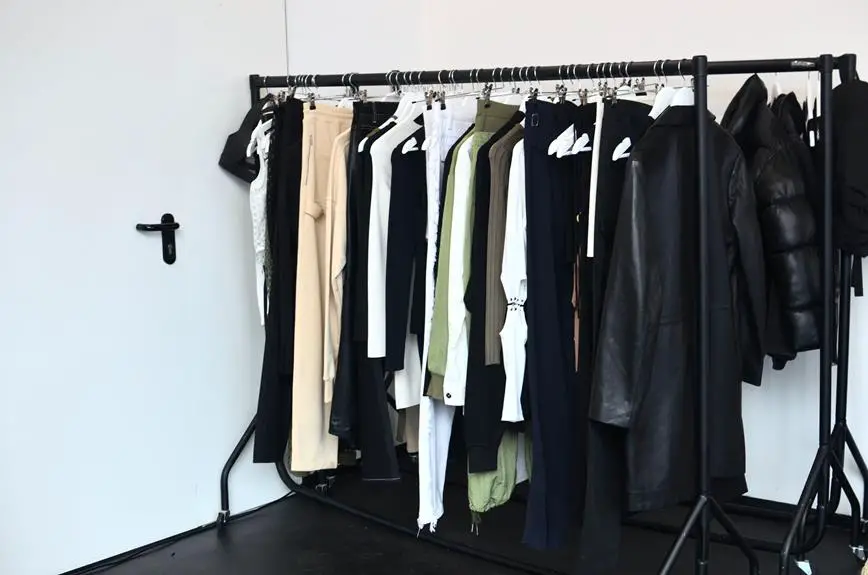You've probably wondered if alterations can actually expand fabric sizes. The answer is yes, and understanding how to make alterations work for you can help you achieve the perfect fit for any garment.
With the right techniques and fabric choices, you can effortlessly expand the size of your clothing to ensure a flattering and comfortable fit. This mastery of fabric alterations will empower you to maximize your wardrobe and confidently select and modify garments to suit your unique style and body shape.
By working with professional tailors or learning some DIY alteration tips, you can achieve the perfect fit and expand fabric sizes to create a wardrobe that makes you feel confident and stylish.
Key Takeaways
- Different fabrics have unique properties that affect how they can be altered.
- Resizing woven fabrics may require techniques like adding or removing darts, seams, or panels, whereas resizing knits may involve methods like taking in or letting out the seams or adding elastic inserts.
- Understanding fabric construction helps determine the best resizing techniques to use.
- Alteration techniques like adjusting seams, dart manipulation, and adding elastic inserts can effectively resize or customize the fit of garments.
Understanding Fabric Alterations
You can achieve a better fit through fabric alterations. Understanding fabric construction is crucial for successful garment resizing techniques. Different fabrics have unique properties that affect how they can be altered. For example, woven fabrics like denim or cotton have less stretch compared to knits like jersey or spandex. This impacts the way you can resize garments made from these materials. Understanding the construction of these fabrics will help you determine the best resizing techniques to use.
When altering woven fabrics, such as denim or cotton, you may need to use techniques like adding or removing darts, seams, or panels to adjust the size. On the other hand, when resizing knits, you might consider methods like taking in or letting out the seams, or adding elastic inserts for a better fit. It's important to understand how different fabrics behave during alterations to ensure the best possible outcome.
Common Alteration Techniques
When altering fabric sizes, consider utilizing common alteration techniques such as adjusting seams, darts, and panels for woven fabrics, or resizing seams and adding elastic inserts for knits. These techniques allow you to modify the size and shape of the garment while maintaining its overall structure and design.
Here are some essential sewing techniques and fabric manipulation methods to help you master the art of fabric alterations:
- Adjusting Seams: Seam adjustments involve taking in or letting out the fabric along the seams to achieve the desired fit. This technique is commonly used to resize garments or customize the fit according to individual measurements.
- Dart Manipulation: Darts are folded and stitched to create shape and fullness in a garment. By altering the placement and size of darts, you can effectively adjust the overall size and silhouette of the fabric.
- Adding Elastic Inserts: For knits, adding elastic inserts to the seams can help accommodate size adjustments while ensuring comfort and flexibility in the garment's fit.
Mastering these sewing techniques and fabric manipulation methods will empower you to confidently alter fabric sizes to achieve the perfect fit.
Selecting the Right Fabric
Considering the alteration techniques previously discussed, it is crucial to select the right fabric for your project to ensure successful size adjustments. The fabric selection plays a significant role in the outcome of your garment construction. Different fabrics behave differently when altered, so choosing the appropriate one is essential for achieving the desired results.
| Fabric Type | Characteristics | Best Use |
|---|---|---|
| Cotton | Breathable, easy to sew | Casual wear, summer dresses |
| Wool | Warm, drapes well | Winter coats, formal wear |
| Silk | Luxurious, delicate | Evening gowns, formal blouses |
When selecting a fabric, consider its weight, stretch, drape, and weave. A heavier fabric may not be suitable for a fitted dress, while a light, flowy fabric might not work well for structured garments. Understanding these characteristics will empower you to make informed decisions and achieve mastery in garment construction. Remember, the right fabric can make all the difference in the success of your size alterations.
Maximizing Garment Fit
You can maximize garment fit by utilizing alteration techniques for sizing and customizing garment measurements.
This allows you to achieve the perfect fit for your body, ensuring that your clothing complements your shape and style.
Alteration Techniques for Sizing
Maximize your garment fit through effective alteration techniques for sizing. When mastering garment adjustments, consider these three key techniques:
- Sewing Techniques:
Mastering sewing techniques is essential for altering garment sizes. Understanding how to take in or let out seams, adjust darts, and reposition closures can make a significant difference in achieving the perfect fit.
- Garment Adjustments:
Learning how to make precise garment adjustments, such as shortening or lengthening hems, adjusting shoulder widths, or repositioning waistlines, can transform the overall fit and comfort of your clothing.
- Pattern Alterations:
Understanding how to alter patterns to match your unique body shape and size is crucial for achieving a customized fit. Whether it's adjusting the bust, waist, or hips, knowing how to modify patterns ensures a tailored fit for every garment.
Mastering these alteration techniques will empower you to expand fabric sizes and achieve the perfect fit for your garments.
Customizing Garment Measurements
To achieve the perfect fit for your garments, focus on customizing the garment measurements to maximize your comfort and style. Custom fit is key to ensuring that your clothing feels tailored specifically for you.
When customizing garment measurements, consider the various tailoring options available to achieve the ideal fit. Whether it's adjusting the length of sleeves, altering the waistline, or modifying the shoulder width, tailoring your garments can make a significant difference in how they look and feel on your body.
Take advantage of tailoring services offered by professionals who can expertly customize your clothing to your unique measurements. By customizing garment measurements, you can maximize the fit of your clothing, enhancing both your comfort and confidence in your style.
Working With Professional Tailors
When working with professional tailors, it's important to communicate your specific alteration needs clearly and provide accurate measurements to ensure the best results. Tailor expertise plays a crucial role in achieving the perfect fit for your garments. Here are essential tips for working with professional tailors:
- Detailed Communication: Clearly articulate the changes you desire for your garment. Whether it's adjusting the waistline, shortening sleeves, or altering the hem, providing specific details helps the tailor understand your expectations accurately.
- Accurate Measurements: Precise measurements are fundamental for successful garment modifications. Take accurate body measurements or have them taken by a professional to ensure the tailor has the proper information to work with.
- Open Collaboration: Establishing a collaborative relationship with your tailor can lead to exceptional results. Be open to their professional advice and expertise, as they may offer valuable insights into achieving the best possible outcome for your clothing alterations.
DIY Fabric Alteration Tips
Looking to adjust the size of your fabric on your own?
Let's talk about some DIY fabric alteration tips. From altering fabric for fit to techniques for resizing fabric, you'll find some helpful pointers for making adjustments to your fabric.
Whether it's adjusting the size of a garment or repurposing fabric for a new project, DIY fabric size adjustments can be done with some simple techniques.
Altering Fabric for Fit
Consider using basic sewing techniques to adjust the fit of your fabric and create a more personalized garment. When altering fabric for fit, keep these tips in mind:
- Fabric Resizing: Understand how to take in or let out seams to accommodate your body shape. This involves measuring and marking the fabric accurately before making any adjustments.
- Garment Modification: Learn to modify the garment's design to suit your preferences. This could include altering the neckline, sleeve length, or even adding darts for a better fit.
- Fabric Customization: Experiment with different fabrics and textures to customize the look and feel of your garment. Understanding the properties of various fabrics will help you choose the best one for your desired fit.
Techniques for Resizing Fabric
To resize fabric effectively, you can utilize various DIY alteration techniques to adjust the fit and expand the size, allowing for a more personalized and comfortable garment.
Resizing techniques such as adding fabric panels, inserting gussets, or incorporating extension pieces can help increase the overall size of the garment.
Additionally, fabric enlargement methods like creating new seams, adjusting darts, or utilizing fabric inserts can also aid in resizing the fabric to better fit your body.
These techniques require careful measurement, cutting, and sewing to ensure a seamless and professional outcome.
DIY Fabric Size Adjustments
Are you struggling to find clothing that fits just right? When it comes to DIY fabric size adjustments, mastering the art of fabric resizing and sewing techniques is essential. Here are three key tips to help you achieve the perfect fit:
- DIY Tailoring: Learn basic sewing techniques and invest in quality sewing tools to tailor your garments to fit your unique body shape. Understanding how to take in or let out seams can make a significant difference in the way your clothing fits.
- Fabric Adjustments: Experiment with different fabric resizing methods such as adding fabric panels or using clever pleating techniques to adjust the size of your clothing. Understanding how to alter patterns and adjust fabric can make a world of difference in achieving the perfect fit.
- Practice Precision: Take your time and practice precision when making fabric adjustments. Small, careful alterations can make a big impact on the overall fit of your garments.
Achieving Flattering Results
Strive to achieve flattering results by focusing on the fit and silhouette of your clothing through alterations.
Embracing body positivity means celebrating your unique shape and enhancing it with flattering silhouettes.
When altering your clothing, emphasize creating a well-defined waistline to accentuate your curves or achieve a more balanced look. Tailoring the waist of dresses and tops can instantly transform the overall appearance, providing a more proportionate and flattering silhouette.
Additionally, consider altering the length of pants and skirts to ensure they hit at the most flattering point on your body, elongating your legs and creating a streamlined look.
A well-fitted garment can greatly boost confidence and contribute to a positive self-image. By mastering the art of alterations, you can personalize your wardrobe to complement your body shape, promoting a sense of empowerment and style that's uniquely yours.
Frequently Asked Questions
Can Alterations Be Done to Increase the Size of a Fabric Beyond Its Original Dimensions?
You can increase fabric size through alterations. This tailoring option offers potential benefits for customizing garments. How to expand fabric sizes depends on the material and construction, but skilled alterations can help achieve the desired fit.
Are There Limitations to How Much a Fabric Can Be Altered in Terms of Size Expansion?
When it comes to fabric alteration, there are limitations to how much you can expand the size. Sizing can be adjusted, but fabric expansion has constraints based on the original dimensions and material properties.
What Are the Potential Risks or Downsides to Altering Fabric to Increase Its Size?
When altering fabric to increase size, potential risks include compromising fabric integrity, exceeding stretching limitations, and damaging delicate materials. Mastery requires careful consideration of these factors to ensure successful alterations without compromising quality.
How Do Alterations for Size Expansion Differ for Different Types of Fabrics (E.G. Stretchy Vs. Non-Stretchy)?
When altering stretchy fabric, expansion techniques like adding panels or gussets are effective. Non-stretchy fabric presents alteration challenges due to limited seam allowances. Consider using complementary fabrics or creative seam placement for successful size expansion.
Are There Specific Alteration Techniques or Considerations for Expanding the Size of Specialty or Delicate Fabrics?
When altering specialty or delicate fabrics like silk chiffon or a lace wedding dress, specific techniques and considerations are essential for expanding sizes without compromising the fabric's integrity. Mastery in these alterations is crucial.
- How Does Ring Spun Cotton Affect Garment Fit and Shape Retention? - August 13, 2024
- What Are the Challenges in Producing Ring Spun Cotton? - August 13, 2024
- Is Ring Spun Cotton Suitable for Plus-Size Clothing? - August 13, 2024







